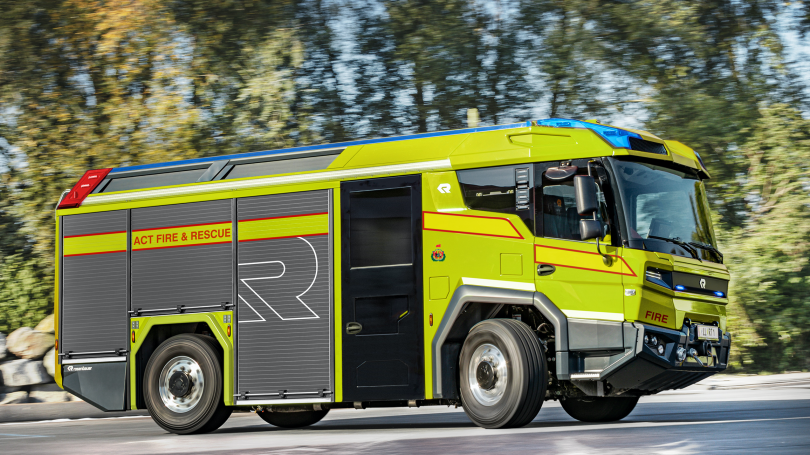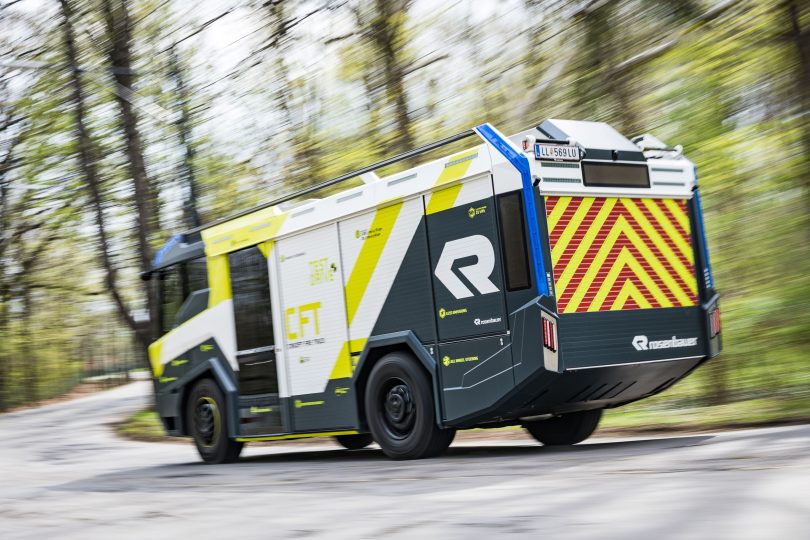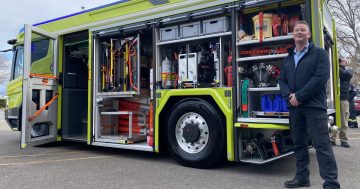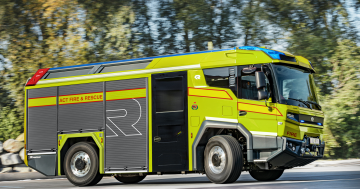
An artist’s impression of the new fire truck wearing its ACT Fire and Rescue colours. Photo: ESA.
The siren is the only thing you’ll hear when the ACT’s electric fire truck comes to town.
The ACT Emergency Services Agency (ESA) will take delivery of Australia’s first Plug-In Hybrid Electric Fire Truck in the first half of next year.
The plans date back to August 2019 when the ACT Government announced it would work with Austrian company Rosenbauer to pioneer the engineering of their Concept Fire Truck to suit local fire services.
At the time, the government received some criticism from the United Firefighters Union (ACT UFU). The union only became aware of the deal through media reports.
The union questioned the immediate need for such a vehicle when Canberra’s firefighting teams were facing more significant unresolved issues, including having no official procedure to effectively extinguish battery fires in electric vehicles.
This week, however, a formal agreement was signed and the ACT UFC is on board. No mention has been made of the cost.
Rosenbauer founded an Australian sales and service arm in mid-2017 in Brisbane, overseeing the sale of firefighting vehicles and equipment in Australia and New Zealand.

The truck will come fitted with a drone for aerial reconnaissance. Photo: ESA.
The ‘Revolutionary Technology’ (RT) truck, with its 100 kWh battery pack and backup BMW diesel generator, is expected to reduce diesel fuel consumption by about 185,000 litres over 10 years.
Minister for Police and Emergency Services Mick Gentleman said the new truck would feature a range of benefits for ACT Fire & Rescue firefighters, in addition to providing a significant reduction in emissions produced compared to a conventional diesel-powered fire truck.
“Firefighter safety and comfort is at the forefront of the design of this new truck, and it will feature a better use of its internal space and greater crew protection in comparison to the existing vehicles in our fleet.”
Much like a bus, entry and exit to the truck is via a side door, designed so that firefighters don’t have to stress their backs and knees clambering up and down the side.
The truck will come equipped with solar panels to help recharge the batteries and can be plugged into a high-voltage industrial socket whenever it’s not on duty. A full charge can be reached in 30 minutes, giving 8 to 10 hours of useable driving time.

You won’t be able to miss it. Photo: ESA.
It will also come equipped with a drone for aerial reconnaissance, an ideal extra for bushfires.
Mr Gentleman said the arrival of the Plug-In Hybrid Electric Fire Truck was a crucial component in the ACT achieving its emissions reduction targets.
“The ACT Government has committed to reaching a target of net zero emissions by 2045. Investments in new technology such as the Plug-In Hybrid Electric Fire Truck are a crucial pillar in how we can be innovative in achieving this.”
The RT will sit alongside the 34 diesel-powered vehicles in the ACT Fire & Rescue fleet which currently includes Pumpers, an Aerial Appliance for fighting fires at varying heights, a HAZMAT unit for hazardous materials and two Compressed Air Foam System (CAFS) Tankers.
A report published by the RMIT University in Melbourne earlier this year investigated the efficiency and effectiveness of the ACT Fire Services, using facts and figures from the Productivity Commission.

An ACT firefighting truck in March 2020, hounding the ACT Government for a new EBA. Photo: Dominic Giannini.
The data showed the ACT funds its fire services at a lower rate than Australia as a whole, and despite an increase in this funding over the last 12 months, it still isn’t on par.
Despite having fewer paid and volunteer frontline firefighters, the ACT punches above its weight according to the main effectiveness and efficiency measures such as deaths, injuries, insurance claims, response times and containment of fires to rooms of origin.
Fire also isn’t the only emergency department to see an injection of resources in recent times.
Last week, the ACT Government announced $15.2 million in funding over the next four years to continue the transformation of the ACT Ambulance Service.
This will see improvements to the ACT Ambulance Service and Emergency Triple Zero Communications Centre to support the growing frontline demand for emergency services and five new low-emissions vehicles introduced into the ACT Ambulance Service fleet.




















